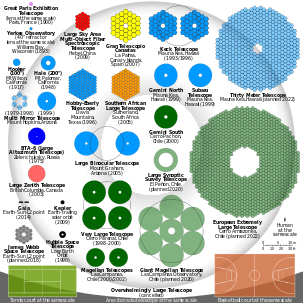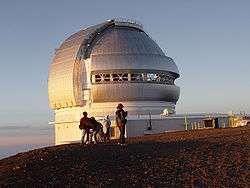Gemini Observatory
|
Gemini North in Hawaii and Gemini South in Chile | |||||
| Organization | Gemini Consortium and AURA | ||||
|---|---|---|---|---|---|
| Location |
Mauna Kea Access Rd, Hawaii, U.S. Cerro Pachón, Chile | ||||
| Coordinates |
19°49′26″N 155°28′11″W / 19.82396°N 155.46984°W 30°14′27″S 70°44′12″W / 30.24073°S 70.73659°W | ||||
| Altitude |
4,213 m (13,822 ft) 2,722 m (8,930 ft) | ||||
| Established | 2000 | ||||
| Website |
www | ||||
| Telescopes | |||||
| |||||
|
| |||||
The Gemini Observatory is an astronomical observatory consisting of two 8.19-metre (26.9 ft) telescopes, the Gemini North and Gemini South at different sites in Hawaii and Chile, respectively. Together, the twin Gemini telescopes provide almost complete coverage of both the northern and southern skies. They are currently among the largest and most advanced optical/infrared telescopes available to astronomers (see List of largest optical reflecting telescopes).
The Gemini telescopes were built and are operated by a consortium consisting of the United States, Canada, Chile, Brazil, Argentina, and Australia. This partnership is managed by the Association of Universities for Research in Astronomy (AURA). The United Kingdom dropped out of the partnership at the end of 2012 and the Gemini Observatory has responded to this by significantly reducing its operating costs, so that no new partners are required beginning in 2013.
Overview



The Gemini Observatory's international Headquarters and Northern Operations Center is located in Hilo, Hawaii at the University of Hawaii at Hilo University Park. The Southern Operations Center is located on the Cerro Tololo Inter-American Observatory (CTIO) campus near La Serena, Chile.
- The "Gemini North" telescope, officially called the Frederick C. Gillett Gemini Telescope[1] is located on Hawaii's Mauna Kea, along with many other telescopes. That location provides excellent viewing conditions due to the superb atmospheric conditions (stable, dry, and rarely cloudy) above the 4,200-metre-high (13,800 ft) dormant volcano. It saw first light in 1999 and began scientific operations in 1998.
- The "Gemini South" telescope is located at over 2,700 metres (8,900 ft) elevation on a mountain in the Chilean Andes called Cerro Pachón. Very dry air and negligible cloud cover make this another prime telescope location (again shared by several other observatories, including the SOAR Telescope and Cerro Tololo Inter-American Observatory). Gemini South saw first light in 1998.
Together, the two telescopes cover almost all of the sky except for two large regions near the celestial poles: Gemini North cannot point north of declination +89 degrees, and Gemini South cannot point south of declination −89 degrees.
Both Gemini telescopes employ a range of technologies including laser guide stars, adaptive optics, multi conjugate adaptive optics, and multi-object spectroscopy. In addition, the telescope allows very high-quality infrared observations due to the advanced protected silver coating of its mirrors, its small secondary mirror (due to the f16 focal ratio), and advanced ventilation systems. Thanks to a high degree of networking, the Gemini telescopes can be operated remotely, and observations can be run when atmospheric conditions suit them best, reducing unnecessary travel by astronomers.
History
The history of the Gemini Observatory featured prominently in Giant Telescopes, a 2004 book by science historian W. Patrick McCray.[2] It details the technical and political challenges faced by scientists and engineers working to construct Gemini and other modern observatories. It is estimated that the two telescopes cost approximately $184 million to construct, and a night on each Gemini telescope is worth about $33,000.[3]
The two 8-meter mirror blanks, each weighing over 22 t (24 short tons), were fabricated from Corning's Ultra Low Expansion glass. Each blank was constructed by the fusing together of and subsequent sagging of a series of smaller hexagonal pieces. This work was performed at Corning's Canton Plant facility located in upstate New York. The blanks were then transported via ship to REOSC, located south of Paris for final grinding and polishing.
One decision made during design to save money was eliminating the 2 Nasmyth platforms. This makes instruments like high resolution spectrographs and adaptive optics systems much more difficult to construct, due to the requirement of them being Cassegrain instruments.
UK funding crisis
In November 2007 it was announced that the UK's STFC had proposed that, to save £4 million annually, it would aim to leave the telescope's operating consortium. At a consortium in January 2008, the conclusion was made that the UK would officially withdraw from the Gemini Partnership and the Gemini Observatory Agreement effective February 28, 2007.. This decision significantly disrupted observatory budgets, and resulted in the cancellation of at least one instrument in development at that time (the Precision Radial Velocity Spectrograph).
Since the reason for the UK breaking its part of the agreement seemed to be entirely financial, there was public outcry, including the "Save Astronomy" movement[4] which asked citizens to speak up against the astronomy budget cuts. The UK rethought their decision to withdraw from Gemini, and requested reinstatement into the agreement, and were officially welcomed back on February 27, 2008. However, in December 2009 it was announced that the UK will indeed leave the Gemini partnership in 2012, as well as terminating several other international science partnerships, due to continuing funding limitations.[5]
Directorship
The first director of Gemini was Matt Mountain, who after holding the post for eleven years left in September 2005 to become director of STScI. He was succeeded by Jean-René Roy, who served for nine months,[6] after which time Doug Simons held the directorship from June 2006 to May 2011. He in turn was succeeded by an interim appointment of the then-retired Fred Chaffee, former director of Keck Observatory. Chaffee was succeeded in August 2012 by Markus Kissler-Patig.[7]
Instrumentation
Adaptive optics
Each Gemini telescope has at least one adaptive optics setup. Gemini-N has ALTAIR, built in Canada, which achieves a 30%-45% Strehl ratio on a 22.5-arcsecond-square field and can feed NIRI, NIFS or GNIRS.;[8] it can use natural or laser guide stars. In conjunction with NIRI it was responsible for the discovery of HR8799b.
Gemini-S has NICI, which is an imager with integrated adaptive optics; it achieves a 35–55% Strehl ratio on an 18.4-arcsecond-square field, but can use only natural guide stars.
On December 16, 2011, the multi-conjugate adaptive optics system GeMS at Gemini South achieved first light;[9] using a constellation of five laser guide stars, it achieved FWHM of 0.08 arc-seconds in H band over a field of 87 arc-seconds square. This feeds two dedicated instruments, GSAOI and Flamingos-2.
An adaptive secondary mirror has been considered for Gemini,[10] which would provide reasonable adaptive-optics corrections (equivalent to natural seeing at the 20th-percentile level 80% of the time) to all instruments on the telescope to which it is attached.
Instruments
Each Gemini telescope is equipped with its own version of GMOS, which can perform multi object spectroscopy, long-slit spectroscopy, imaging, and integral field spectroscopy at optical wavelengths. Each of the 2 GMOS instruments are currently having their detectors upgraded to Hamamatsu arrays, which will have significantly improved performance in the far red part of the optical spectrum (700–1,000 nm).
Gemini's silver coating and infrared optimization allow sensitive observations in the mid infrared part of the spectrum (5–27 µm). This is covered by T-ReCS at Gemini South, and by Michelle at Gemini North, both of which have imaging and spectroscopic cababilities.
Gemini North has NIFS (Near-infrared Integral Field Spectrograph), built by Australian National University. It takes a 30 × 30 array of spectra (covering a three-arcsecond-square field) at R=5000 in the 0.95–2.4 µm wavelength range.
It also has Phoenix, a high-resolution infrared spectrograph build by NOAO of the United States, although this instrument is no longer offered.
Gemini South has GSAOI, a 16-megapixel IR camera built by ANU which is attached to GeMS, and also:
- NICI, the Near-Infrared Coronagraphic Imager, built by the University of Hawaii and NOAO.
- GPI, the Gemini Planet Imager,[11] built by a consortium of US and Canadian institutions to fulfil the requirements of the ExAOC Extreme Adaptive Optics Coronagraph proposal.
Instrumentation development issues
The first phase of Gemini instrumentation development did not run smoothly; schedules slipped by several years, and budgets sometimes overran by as much as a factor of two. In 2003 the instrument-development process was re-analysed in the Aspen report;[12] for example, an incentive program was introduced where instrument developers were guaranteed substantial allocations of telescope time if they deliver the instrument on time and lose it as the instrument is delayed.
A wide-field multi-object spectrograph achieved substantial scientific support, but would have required very substantial changes to the design of the telescope - effectively it would have required one of the telescopes to be devoted to that instrument. The project was terminated in 2009.[13]
Second-round instrumentation development
In January 2012, the Gemini Observatory started a new round of instrumentation development.[14] The first two instruments involved are a high-resolution optical spectrograph (provisionally named GHOS) and a medium-resolution wide-band (350 nm to 2.5 µm in a single exposure) spectrograph (GIROS).
See also
References
- ↑ "Gemini Telescope on Mauna Kea Named in Honor of Dr. Frederick C. Gillett | Gemini Observatory". Gemini.edu. Retrieved 2013-11-15.
- ↑
- ↑ "Ausgo Faq". Ausgo.aao.gov.au. Retrieved 2013-11-15.
- ↑ "Study Astronomy Online". Saveastronomy.org.uk. Retrieved 2013-11-15.
- ↑ Archived December 22, 2009, at the Wayback Machine.
- ↑ "AURA and Gemini Observatory Announce New Director | SpaceRef - Your Space Reference". SpaceRef. 2006-02-20. Retrieved 2013-11-15.
- ↑ "AURA selects Kissler-Patig as new Gemini Observatory Director". 2012-03-23. Retrieved 2012-03-24.
- ↑ "Gemini Observatory : Adaptive Optics Instrumentation and Capabilities" (PDF). Noao.edu. Retrieved 2013-11-15.
- ↑ "Revolutionary Instrument Propels Astronomical Imaging to New Extremes | Gemini Observatory". Gemini.edu. Retrieved 2013-11-15.
- ↑ "Gemini Ground Layer Adaptive Optics Feasibility Study Report" (PDF). Gemini.edu. Retrieved 2013-11-15.
- ↑ "Gemini Planet Imager". Planetimager.org. Retrieved 2013-11-15.
- ↑ "Managing Gemini Observatory's Future Instrumentation Program" (PDF). Lna.br. Retrieved 2013-11-15.
- ↑ "Gemini Board WFMOS Resolution | Gemini Observatory". Gemini.edu. 2009-06-01. Retrieved 2013-11-15.
- ↑ "Call for White Papers to define the Gemini InfraRed-Optical Spectrometer (GIROS) | Gemini Observatory". Gemini.edu. Retrieved 2013-11-15.
External links
- Official website
- Gemini Observatory Image Gallery
- UK Re-instated as Partner in Gemini
- Save Astronomy
- UK Update of Gemini Partnership
- Resolution of UK Partnership Issue
- Photos of Gemini and other Mauna Kea observatories from A Gentle Rain of Starlight: The Story of Astronomy on Mauna Kea by Michael J. West. ISBN 0-931548-99-3.
- "Science funding cuts to hit UK astronomers"—The Daily Telegraph